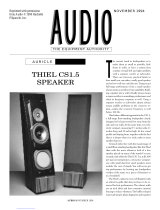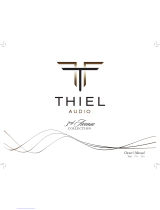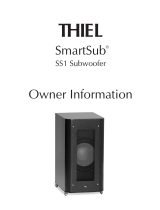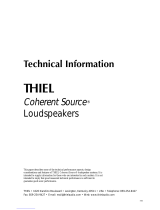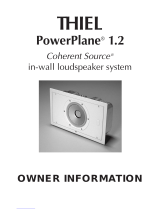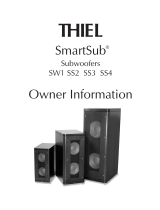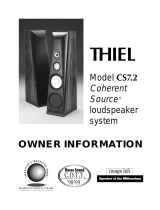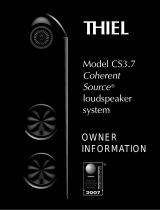Page is loading ...

I am tempted to begin this review with the statement that the Thiel
MCS1 is too good a speaker for surround sound. This is the kind of
snotty remark, however, that ignores the fact that high quality movie
soundtracks deserve high quality speakers as much as music. It also ignores
the potential of surround music—a potential that has become much more
real from demonstrations of surround sound SACD. At the same time, such a
remark does dramatize the fact that the MCS1 is an exceptionally musical
speaker for the money as well as an exceptional speaker for a home theater or
surround system.
Accordingly, the real reason that that I have decided not to begin this review
by saying that the Thiel MCS1 is too good a speaker for surround sound is
that saying a Thiel speaker provides outstanding musical performance for the
money simply isn't necessary. Audiophiles already know that Thiel has long
been one of the top speaker manufacturers in the U.S., and it was almost
inevitable that Jim Thiel would build upon his experience with stereo to
design products for surround sound.
The MCS1 sells for $2,200 a speaker. It is a relatively compact 10 x 12.5 x 28.5 (w x d x h) inches, and weighs 61 pounds. This is
relatively small for a stereo monitor, although “big” by left and right satellite, center channel, side channel, and rear channel
standards. The MCS-1 comes in a wide range of finishes, stands are an available for vertical or horizontal placement, and it comes
in a wide range of finishes. As is the case with all Thiel speakers I have encountered, it is built in-house, and the woodwork and
finish are superb. Aside from the fact that the MCS1 is magnetically shielded, and is designed for stand mounting, it has the same
basic components and design features as other products in the Thiel line.
In spite of its small size, it is a three-way system with a dome tweeter, midrange,
and two woofers. All of the drivers in the MCS1 use aluminum as a diaphragm
material because Thiel feels it has much higher stiffness and compressive strength
than conventional diaphragm materials, and reduces cone break-up, diaphragm
resonance, and “ringing” in each driver’s operating range. It is a dual ported
system.
The 1" metal dome tweeter is coaxially mounted in a 3.5" metal cone, short coil/
long gap midrange. The two drivers’ diaphragms share the same voice coil, a
design that is also used in the Thiel PCS and CS2.3. This technique allows the elimination of the midrange/tweeter section of the
electrical crossover network as the drivers’ structure provides a mechanical crossover. Thiel feels this design allows drivers to
achieve better time coherence. Such drivers can provide superior time alignment because the sound sources of both drivers are in
the same location, and therefore the outputs of both reach the listener at the same time.
The two 6.5" woofers have short coil/long gap, copper stabilized motor systems, cast aluminum chassis, and 2.2 pound magnets to
increase output capability and efficiency. Thiel feels the use of a short coil/long gap voice coil design causes the intensity of the
magnetic field acting on the coil to be constant during movement. Normally, the driver’s the magnetic field changes in intensity as
The following review in reprinted in its entirety from the review that Anthony H. Cordesman submitted to Audio just before it closed. It
has been given to us to reproduce in its original form and represents the personal views of the author. Anthony Cordesman is now a
senior reviewer for The Absolute Sound.
…the MCS-1 is an
exceptionally musical
speaker for the money, as
well as an exceptional
speaker for a home theater
or surround system.
The Thiel MCS-1 Home Theater Speaker:
Too Good For Surround Sound?
by Anthony H. Cordesman

the voice coil moves forward and backward in the magnetic
gap, producing distortion. Thiel also uses a copper sleeve
around the center pole in the woofer and midrange driver to
cancel unwanted changes in magnetic field strength caused by
the amplifier’s current through the voice coil. The result is
again a more stable magnetic field and reduced distortion.
The crossover in the MCS1 is what Thiel calls “phase correct.”
Jim Thiel seeks to preserve the phase coherence and the
harmonic integrity of the music by ensuring that all drivers
must move in and out in step with each other and with the
speaker's input signal. He uses wide
bandwidth drivers in conjunction with
crossover systems that are designed to
provide phase coherent transitions
between drivers. He feels that this
requires the use of first-order crossover
networks (6 dB/octave) because more
complex networks discriminate between
frequencies in ways that cause the phase
of the signal to be shifted, and causes the drivers to move out
of step with each other.
Thiel notes, for example, a second-order network which
reduces the high frequencies to one-fourth for each doubling
of frequency (12 dB/octave) will cause the phase of the higher
frequencies to be shifted almost 180°. A fourth-order network
will cause the higher frequencies to lag almost 360°, or one
complete cycle. Since one cycle represents a different amount
of time for different frequencies, the network smears the
frequencies in time. It also causes the individual harmonic
components of each sound, which are reproduced simulta-
neously by different drivers, to lose their synchronous struc-
ture. This loss is caused by the negative and positive motions
of the drivers being out of step with the input signal. This
changes the waveform and results in the loss of spatial and
transient information.
In contrast, Thiel states that the first-order crossover system
used in the MCS1 and his other speakers keep the phase shift
of each filter to less than 90° so that it can be canceled with a
filter that has an identical phase shift in the opposite direction.
The phase shift is kept low by using very gradual (6 dB/octave)
roll-off slopes that produce a phase lag of 45° for the low
frequency driver and a phase lead of 45° for the high fre-
quency driver at the crossover point. Because the phase shift of
each driver is much less than 90° and is equal and opposite,
their outputs combine to produce a system output with no
phase shift and perfect transient response. Thiel feels that
other types of crossover system cannot completely eliminate
time smear and phase shift.
The network in the MCS1 also corrects for small tonal
irregularities, improving frequency response. It uses pure
polystyrene and polypropylene capacitors, and air-core induc-
tors wound with high purity copper wire to preserve sonic
information for even greater fidelity.
A design feature that is critical for home theater and surround
sound purposes is that the MCS1 is matched in timbre and its
other sound characteristics with Thiel’s other high performance
speakers such as the CS6 or CS7.2. This means that the
MCS1s can either be used for all channels in a surround
system, be used as rear and center speakers with a pair of larger
monitors like CS7.2s for the front channels, or be used with
Thiel’s new rear and surround
channel speakers, the PowerPoint
and PowerPlane.
As for specifications, the MCS1 has
unusually extended frequency
response for a home theater speaker.
Its bandwidth is 47 Hz-23 kHz (-3
dB), and its amplitude response is 50
Hz-20 kHz (±2 dB). Its phase response is a minimum ±10°. Its
sensitivity is 90 dB at one meter with a 2.8-volt input, and its
impedance is 4 ohms (3 ohms minimum).
I wouldn’t bother going into so much technical detail if the
MCS1 did not meet the acid test of superior sound quality, and
if the sound quality of the speaker did not track so closely with
the engineering goals that went into its design. I shouls also
note that I am convinced enough with the overall merits of
Thiel designs to use the Thiel CS7.2 as one om my references.
At the same time, I should qualify my praise for the sound
quality of the MCS1 by saying that I have heard excellent
sounding speakers that break most or all of the design rules that
Jim Thiel has used in designing, and which use radically
different design principles, materials and enclosures. I have
never found that sonic excellence is limited to one design
approach, or even to one type of speaker—whether dynamic,
ribbon, or electrostatic. Ultimately, the quality of the execution
of a given design approach that seems to matter more than any
given set of engineering and design characteristics.
That caveat aside, the MCS1 is an intensely musical speaker for
the money. I review home theater speakers in two ways. First, in
terms of their performance in my reference stereo system, and
second in terms of their performance in my reference with a
home theater/surround system. What struck me immediately
about the MCS1 was how good it sounded in my stereo
reference system, and how much “larger” it sounded than its
size initially indicated.
Placed vertically on a stand with the tweeter near ear height, it
sounded much more like a large floor mounted speaker. The
timbre was also simply right. I generally pay more attention to
the overall timbre of a speaker and its realism with recordings of
Thiel has long been one of
the top speaker
manufacturers in the U.S.

acoustic (unamplified) instruments than any other aspect of
sound. I am particularly concerned with the timbre of strings,
soprano voice, and piano because any speaker that does not get
the timbre right with these aspects of music eventually becomes
irritating and fatiguing, regardless of how well it does in other
respects.The MCS1 did very well in these respects. I use some
very difficult string octets for reviewing that have extremely
complex imaging and depth and which are recorded on the
edge of being bright. (One is the L‚Archibudelli & Smithsonian
Chamber Players, “Mendelsson and Gade,” Octets for Strings,
Sony SK 48 307). They serve as an
almost instant test of whether a speaker
will really be musical in timbre with a
wide range of music. At the same time, I
use “warm” recordings to determine
whether a speaker is too warm and
lacking in upper midrange and treble
energy. (Roel Dieltiens, “Vivaldi,
Concertos pour Violincelle,” Harmonia
Mundi HMC 901655). Throw in a Judy
Collins recording of virtually any venue,
and you get a slightly harsh female voice
with a high level of aspiration that can sound good
with natural timbre and edgy with poor timbre. Similarly the
timbre and detail of the MCS1 proved to be very good to
excellent with winds and brass, even with slightly hard material
like the Capella Istropolitana recording of “Vivaldi Wind and
Brass Concerti” (Naxos 8.550386). The MCS1 came close to
the golden mean with all of this material, and did significantly
better than most of the speakers I have reviewed in its price
range.
The MCS1 did equally well in reproducing detail. It will not
suit those audiophiles who want a bit of excessive upper
midrange energy and/or a dip in the lower midrange to give a
speaker added detail. In spite of its use of metal diaphragms, it
is slightly sweet in the treble. It also has a rich upper bass/lower
midrange. At reasonable listening distances (six feet or more),
however, it provides a very detailed sound that is filled with
natural musical information and detail. I was struck at the level
of resolution in reproducing complex choral music and in the
consistency of detail and timbre even in reproducing large-scale
symphonic climaxes. The MCS1 may not have the same
dynamic capacity as some larger speakers, but it is very good for
its size. Its combination of consistency, power handling capabil-
ity, and reproduction of sudden transient peaks sounds consid-
erably more natural than that of many others speakers designed
for home theater purposes.
The MCS1 is not a speaker whose frequency range extends into
deep pipe organ, synthesizer superbass, or ultimate bass drum
levels. It does do very well with classic rock, acoustic jazz, and
bass-rich classical material. For example, there is a lot of
excellent bass and demanding percussion detail on the Aurora
recording of “Aurora” (Denon CY-73148), and the MCS1
provided excellent sound. The same was true of its ability to
reproduce the string bass line on Kozeluh, “Works for Wind
Ensemble,” Orfeo C 442 981. This is a nice combination of
winds and strings and the MCS1 did well in every respect. I
should also note that the MCS1 was perfectly acceptable even
with demanding deep bass heavy material like the Reference
Recordings record of “Pomp & Pipes” (RR-58CD) and the
Jenifer Warnes superbass chestnuts on bands 1 and 2 of “The
Hunter” (Private Music 01005-82089-2). If you get the upper
and mid-bass right, the lack of deep
bass is a lot less striking.
The dispersion was good enough at
realistic listening distances (again,
over six feet) to produce a wide,
stable listening area and one unusu-
ally insensitive to speaker toe in and
distance from the rear and side walls.
(Note: These placement issues were
still very important. They were simply
less critical than usual with the
MCS1.)
Imaging was very good, stable and natural. Depth and overall
soundstage size were very good with chamber music and jazz
groups, but not as realistic with larger scale music as larger
speakers. You need the deep bass to throw a truly convincing
soundstage with such music.
Now, what about home theater? Well, the answers here have to
be a bit preliminary. As might be expected, the MCS1 did just
as well in reproducing the timbre and detail of demanding
sound tracks as it did in reproducing stereo music. It had
enough resolving power to clearly pick up the differences in
sound character between the Meridian 800, Theta Casablanca,
and Lexicon MCS1s I use in my front end, and it extracted a
great deal of ambient detail and background sound, as well as
the details of dialogue and music.
I have no hesitation about recommending the MCS1 as a
center channel, and as left and right main channels in a system
using a subwoofer. The MCS1s do not have enough deep bass
and dynamics to operate independently as full range left and
right main channels in a home theater system. This takes a
speaker with deep bass like the CS7.2 or CS6. At the same
time, they do have enough bass and power handling capability
at other frequencies to provide much better performance than
many other medium size home theater speakers. I would note
that I found they sounded better in systems with an adjustable
crossover going down to 60 Hz, than the standard 80Hz
crossover used in many AV processors. This is a sign of unusu-
ally good subjective bass performance in a speaker in this size
and price range since many speakers that claim to perform well
I wouldn’t bother going
into so much technical
detail if the MCS1 did not
meet the acid test of
superior sound quality

with an 80 Hz crossover are actually bass shy enough to sound
better at 100 Hz. Other reviewers may, however, feel differently.
There are some experts who argue that a speaker must be flat
down to nearly 40 Hz to be used with an 80 Hz crossover. This,
however, means either a much bigger left or right channel
speaker than the MCS1 or compromises in dynamics and other
respects. I guess that I would rather have musical and
soundstage coherence in the bass by maximizing the effective
range of the MCS1 than sheer power handling capability and
bass that I feel measures better in the crossover region than it
sounds.
The use of the MCS1s for the side and rear channels may be
equally controversial. I found
that the MCS-1s worked very
well for me as side and rear
channel speakers for Dolby
digital, Dolby EX, Dolby Pro
Logic, Dolby Ad Nausea,
DTS, Logic 7, and surround
music. At the same time, they
are not dipole or bipole
speakers. The use of direct
radiators like the MCS1 can
create a very precise sense of direction in a relatively limited
area, and do so in a way I feel sounds considerably better than
bipoles or dipoles. You can also broaden the apparent sound
stage and feeling of ambiance simply by directing the speakers
so they reflect more energy or by moving them back from the
listening position. Any direct radiator does, however, still give
up some degree ambiance and the appearance of realism in the
broad sound field create by sounds like wind or rain. I’d suggest
some hard listening at a dealer or a friend’s to decide what kind
of side and/or rear channel sound you really want.
As for subwoofers, I used the MCS1s with the subwoofers with
my Polk SRTs, a Vandersteen V2W owned by a friend, and the
REL Storm IIIs. The REL Storm IIIs worked best, hooked up
in a configuration where one or two Storm IIIs were driven by
the effects (subwoofer) output of my reference AVPs in playing
back movie soundtracks, but were hooked up directly to the
output of the left and right channel amplifiers for stereo and
surround music. This allowed all hell to break loose in the
louder parts of movie soundtracks while it provided the most
natural sound in music. Incidentally, I set the crossover in the
REL Storms to around 42 Hz for music because these
subwoofers supplement the sound of the MCS1s when they are
hooked up directly to the left and right channel amplifiers
rather than use are high pass crossover to restrict the bass of the
MCS1s. A point of reviewer bias. No matter what I did, I could
hear slight to moderate colorations around the crossover point
between the MCS1s and the subwoofers. This, however, is true
of every system I have ever listened to in which the subwoofer
was not made by the same firm as the upper channels; where
the main channels and subwoofer were not designed with a
specific crossover (or dedicated crossover) in mind; and where
the end result is not unusually accurate. I realize other reviewers
and many audiophiles are not bothered as much by such
problem in the bass as I am, and I have to admit that the special
crossover features in the REL Storm III allowed my to get very
close to flat sound. Further, the fact that the REL Storm III
supplements the sound of the MCS1 in music, rather than
requires a high pass filter that reduces the bass response of the
MCS1, really helped in getting the best out of the MCS-s.
Nevertheless, there were still differences in apparent driver speed
and every adjustment I tried either produced a slight boost or
dip around the crossover
frequency. The result was
similar to the sound of a very
good full-range speaker
system with deep bass
extension where things are
not quite right in the transi-
tion to the lowest frequency
bass driver. I can’t criticize
the MCS1 in these respects
relative to other speakers of
its type. Every home theater speaker that is not part of a dedi-
cated home theater system presents this problem and so do at
least 80% of the home theater systems that do have a dedicated
subwoofer. For example, many THX audio-video systems have
clearly audible transitions between the left and right channels
and subwoofer in spite of a largely productive effort to ensure
high standards, and the subwoofer in such systems is often
audibly slower, dragging down the speed of the dynamics and
definition of the bass.
At this point, however, I have good news to add to my praise of
the MCS1. Thiel had new PowerPoint and PowerPlane side and
rear channel speakers at the CES in Vegas in January and it
showed the prototype of an exciting new approach to subwoofer
design that could match the MCS1 to a dedicated Thiel
subwoofer and electronic crossover. They also had the prototype
of a 10-channel audio processor with variable crossovers and
room correction for both the main speakers and subwoofer.
This means that by the time you read this review, Thiel should
have a full-range and integrated home theater system available to
use with the MCS1, and the first of what promises to be a series
of audio processors with variable crossovers and room correction
for any mix of speakers. In short, even if the MCS1 is a bit “too
good” for home theater as of the writing of this review, it should
be part of a family of dedicated home theater components by the
time you read it. Certainly, you should take a hard look at the
new Thiel subwoofer. It is one of the few designs I have seen
which really takes a serious approach to ensuring that
subwoofers sound truly natural and not simply deep and loud.
The use of direct radiators like the MCS1
can create a very precise sense of direction
in a relatively limited area, and do so in a
way I feel sounds considerably better than
bipoles or dipoles.
/
